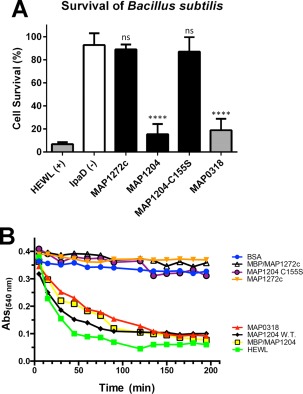Figure 5.

Measurement of hydrolytic activity using B. subtilis and peptidoglycan substrates. (A) Effect of MAP NlpC/P60 domains on viability of B. subtilis. Actively growing B. subtilis cells were incubated with 32 μM of each NlpC/P60 domain protein, known peptidoglycan modifying enzymes (e.g., hen egg white lysozyme (HEWL, 4 μM), or a negative control protein (i.e., S. flexneri IpaD) and plated to assess bacterial viability as described in materials and methods. Total colony forming units were counted, and the results were compared to a mock treatment (culture medium alone) to assess the percent loss of viability. The mean values of each treatment (±SD) were calculated and compared to that of the negative control (IpaD) by an unpaired t‐test to assess statistical significance. ****p ≤ 0.0001; ns, not significant. (B) Hydrolytic activity of MAP_1204 and MAP_1272c on B. subtilis peptidoglycan measured at 540 nm over time. BSA and HEWL are positive and negative controls, respectively.
